Sri Lanka: Account for Wartime Disappearances
More Than 20 People Last Seen in Army Custody Remain Missing

(New York) – The Sri Lankan government should account for everyone who was taken into custody at the end of Sri Lanka’s 26-year-long armed conflict in May 2009 and is feared to have been “disappeared,” Human Rights Watch said today. Despite numerous requests from families for information about their relatives, the authorities do not appear to have conducted any serious investigations, Human Rights Watch said.
Human Rights Watch said unresolved enforced disappearances should be part of the mandate of a proposed United Nations investigation into laws-of-war violations by both government forces and the Liberation Tigers of Tamil Eelam (LTTE). A Panel of Experts appointed by United Nations Secretary-General Ban Ki-moon to advise him on steps for ensuring accountability for laws-of-war violations in Sri Lanka is expected to hand over its report later in April 2011.
“The Sri Lankan government needs to respond to all allegations of disappearances with more than a ritual blanket denial,” said Brad Adams, Asia director at Human Rights Watch. “Family members of the disappeared have the right to know if their loved ones are alive or dead.”
Through interviews with relatives of the missing and witnesses, published testimony, and media reports, Human Rights Watch found that more than 20 people who were taken into army custody between May 16 and 18, 2009, appear to have been forcibly disappeared. Most of them are known to have been detained in the Vadduvaakal area, just south of the strip of land in northeastern Sri Lanka where the final battle between the LTTE and government forces occurred. At the time, the area was controlled by the Sri Lankan army’s 59 Division.
Under international law, an enforced disappearance occurs when the authorities take an individual into custody but refuse to acknowledge doing so or do not provide information about the person’s whereabouts or fate. Among the rights an enforced disappearance may violate are those to life, liberty, and security of the person, including protection from torture and other ill-treatment.
The people believed to have been forcibly disappeared were detained at various times. About half the people involved in the cases documented by Human Rights Watch were detained when dozens of LTTE members surrendered to the army together with the Rev. Francis Joseph, a Catholic priest, south of the Vadduvaakal bridge on May 18. “Aananthi” (not her real name), the wife of one of the disappeared, told Human Rights Watch that she saw the army load the priest and the LTTE members onto a bus and drive them away. Human Rights Watch interviews with other witnesses and numerous media reports confirm her account. The wife and two children, ages 3 and 5, of an LTTE member were also taken away on the bus. The family members and Joseph remain missing.
Aananthi told Human Rights Watch that she has had no news about her husband since:
I have searched in all the camps. I went to the Defense Ministry. I filed a complaint with the police in January 2010. But I have received no information about my husband. The police only told me that it would be difficult for them to find him since the area where he went missing is under military control. I want the government to tell me what happened to him. Whether he is dead or alive, I want an answer.
Asked specifically about Yogiratnam Yogi, one of the men taken away on the bus, the Sri Lankan commissioner general for rehabilitation said in July 2010 that he was not among more than 11,600 LTTE cadres in custody. Human Rights Watch has established the names of several other people who were taken away on the same bus, but it has not been possible to confirm whether they remain missing.
In another disappearance case, a witness told Human Rights Watch that two former LTTE members helped government soldiers identify Colonel Ramesh, an LTTE leader, among the fleeing population and took him and three others away to a small hut nearby. Ramesh’s family has not received any news about him since he was detained. In December 2010 several media outlets broadcast a video clip obtained by the Global Tamil Forum that allegedly showed Ramesh in custody.
Human Rights Watch has obtained several additional, longer videos of Ramesh, providing further evidence that he was in army custody. In one of the videos, Ramesh is seen lying on a bench in civilian clothes. In four other videos, several soldiers stand around Ramesh while one of the soldiers questions him about where he is from, the whereabouts of the wife of LTTE leader Velupillai Prabhakaran, and how he received an injury on his back. At one point it seems that the soldiers are telling Ramesh that the date is the 22nd, suggesting that the video may have been filmed on May 22, 2009. A sixth video shows only Ramesh answering questions about when he joined the LTTE, what his position is, and his family members.
A Sri Lankan military spokesperson dismissed the December video as fake and claimed that Ramesh had been killed during the last days of the war.
On May 17, army soldiers detained Paramnantham Kokulakrishnan and two other men just north of the Vadduvaakal bridge. Kokulakrishnan’s wife told Human Rights Watch that the soldiers did not allow her to accompany her husband even though he was blind from an injury that he had received in 1996. The soldiers told her that they would interrogate the men and then release them, but she has not had any news of her husband since. Kokulakrishnan’s family filed a complaint with the police in October 2010. The police replied in a letter that they would investigate the disappearance, but the family has received no information.
Another witness told Human Rights Watch that five people are still missing after they were separated from the rest on May 17 just south of the Vadduvaakal bridge. Among the missing is Sudarsani Krishnakumar. Her family has filed complaints with the national human rights commission and the police but has received no information about her whereabouts.
In several cases, family members also testified before or filed written complaints with the government Lessons Learnt and Reconciliation Commission (LLRC), which was created by President Mahinda Rajapaksa in May 2010. While the commission has published testimony of government officials and others on its website, it has not published many of the testimonies alleging enforced disappearances by government forces.
The enforced disappearances took place as tens of thousands of people fled the war zone during the last days of the conflict. Government forces registered and screened the fleeing population, separating suspected LTTE members from the others. While family members have been able to locate many of the detainees in prisons or in so-called rehabilitation centers, some are still missing. In its February 2010 report “Legal Limbo: The Uncertain Fate of Detained LTTE Suspects in Sri Lanka,” Human Rights Watch documented the government’s lack of transparency in the screening and registration process.
Human Rights Watch called on the Sri Lankan government to investigate each reported case of enforced disappearances until the fate or whereabouts of the person is clearly and publicly established. The government should prosecute all those implicated in enforced disappearances, including civilian officials and military officers responsible as a matter of command responsibility.
The government should promptly extend an invitation and schedule a visit for the UN Working Group on Enforced and Involuntary Disappearances. The government should also sign and ratify the International Convention against Enforced Disappearance and enact national legislation that gives force to its provisions.
“The Sri Lankan government’s stonewalling on accountability since the end of the war may be most tragic for those whose relatives are missing and feared disappeared,” Adams said. “The government needs to say what has happened to these people and ensure that there are no more cases.”
https://www.hrw.org/news/2011/04/07/sri-lanka-account-wartime-disappearances
—————————————————————————————————————–
280 missing Tamils identified to be in Sri Lanka’s custody in final conflict days – ITJP
15 May 2018
The International Truth and Justice Project released a list of 280 names of forcibly disappeared Tamils, including the names of at least 29 children today.
The list is corroborated by an eyewitness in the North-East and abroad, is the start of a new project by the ITJP to build a list of all those that surrendered themselves to Sri Lanka’s armed forces at the end of the armed conflict in 2009.
“This is the largest single group of enforced disappearances in Sri Lanka’s history- hundreds of people disappearing at the same time and place with multiple eyewitnesses both inside and outside the country. We have written to the Office of Missing persons saying this is the first case they should investigate if they are serious about criminal accountability for enforced disappearance. They can start questioning Major General Shavendra Silva and General Jagath Jayasuriya, whom eyewitnesses say personally observed the surrenders and those security forces in whose custody they were placed,” the ITJP’s Director Yasmin Sooka said in a press statement released today,
The statement reads:
The 58th Division of the Sri Lankan Army has to date steadfastly refused to hand over a list of surendees from the final day of the war to families who filed a habeas corpus case in Sri Lanka. The 58 Division, which is named in the UN Investigation as accepting the surrenders, was led at the time by alleged war criminal, Major General Shavendra Silva, who has been promoted by the current Government to Adjutant General of the Sri Lanka Army. Witnesses indicated that Silva was present at the Wadduvakkal Bridge on 18 May and even shook hands with LTTE political wing leaders who surrendered and shortly thereafter were summarily executed.
The ITJP’s disappearance website is recreating the surrender list that the Sri Lankan Army is withholding. It currently contains 280 names and can be viewed online in Tamil and English at http://itjp.bong.international/#lang=english.
Those named on the ITJP list are believed to have been taken into the custody of the Sri Lankan Army on or around 18th May 2009 before they disappeared. Some have been reported as disappeared by their families in Sri Lanka. Witnesses are also in several countries abroad where they have given sworn testimony to the ITJP about who they saw surrendering to the security forces. The ITJP’s website is based primarily on 5 different lists – two from inside Sri Lanka and two collected abroad and a 2017 UN WGEID complaint list that is public. What is concerning is that while there is some overlap between the lists it is not huge, indicating perhaps that some families of LTTE cadres are still frightened to report them missing or that the families are no longer alive to complain.
On the final days of the war the Sri Lankan Army made loudspeaker announcements urging Tamils to surrender promising them an amnesty. AS the Un report states, it is not relevant whether some of those who disappeared were LTTE fighters or not, because they had already passed into the custody of the armed forces and were hors de combat.
See full press release here.
Tamil mothers of the disappeared have been protesting across the North-East for over a year, demanding the Sri Lankan government to release a comprehensive list of all those that surrendered to government forces at the end of the armed conflict in 2009.Related Articles: 15 May 2018: Youths join mothers of the disappeared for a rally in Kilinochchi10 February 2018: Mothers of the disappeared in Vavuniya condemn president’s denial of secret detention camps23 January 2018: Mothers of the disappeared continue their protest in Vavuniya17 December 2017: Sri Lanka’s mothers ask the international community to help find their children – J S Tissainayagam17 August 2017: ‘We are still waiting on Sri Lankan president to fulfil promises’ – Mothers of the disappeared05 August 2017: Tearful prayers on Day 150 of Mullaitivu mothers of the disappeared protest
Sri Lanka’s war 10 years on: Finding Father Francis
17 May 2019
It’s been 10 years since the end of the civil war in Sri Lanka. For thousands of people, missing family members and friends are a constant reminder of the trauma of the conflict. This is the story of Father Francis.

On 18 May 2009, a brutal conflict which lasted almost three decades came to an end. It’s estimated that at least 100,000 people lost their lives. Many thousands are still missing.
The war was fought along ethnic lines. A desire for an independent state amongst parts of the Tamil minority gave rise to an armed separatist rebel group, the Liberation Tigers of Tamil Eelam, also known as the Tamil Tigers. They took on the Sri Lankan military and both sides stand accused of committing atrocities against the civilian population.
On the final day of the conflict, a Catholic Tamil priest led and negotiated the surrender of at least 360 people, including Tamil Tigers and children as young as two. All of them boarded military buses – never to be seen again.
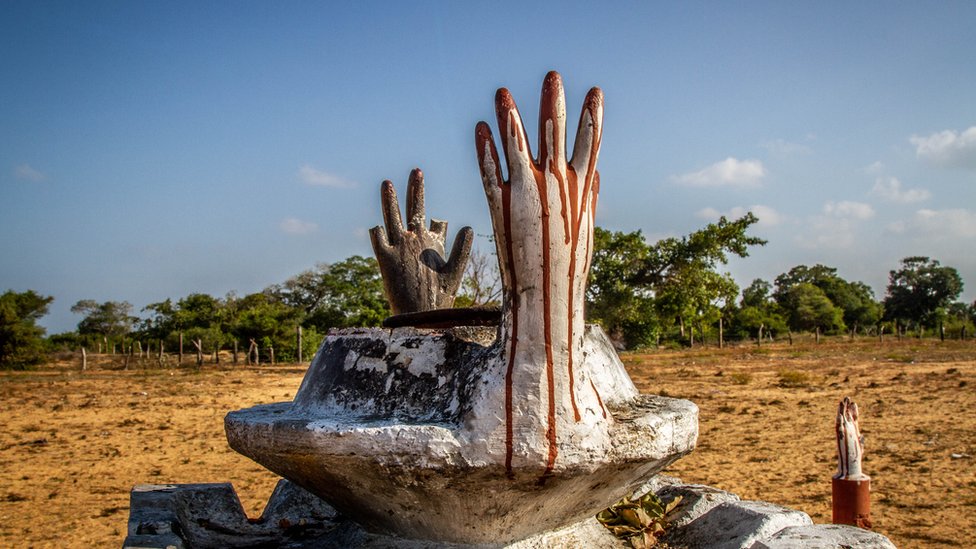
Father Francis was an ardent supporter of Tamil independence but he never picked up arms. Words were his only weapon.
Eight days before the war ended, he wrote a desperate three-page letter to the Vatican pleading for help and expressing a sense of abandonment. It was written in a bunker, now a memorial of concrete blood-stained hands to commemorate the Tamil dead. The BBC contacted the Vatican for comment but is yet to receive a response.

10 May 2009
To His Holiness Pope Benedict XVI,
The Sri Lankan Government is waging the war to annihilate the Tamil nation, it is a genocidal war.
–The cries of woes and agony of the babies and children, the women and the elderly, fill the air that was polluted by poisonous and unhealthy gases.
–It is unfortunate that the Church in Sri Lanka does not have the wisdom and guts to air her views forcefully and unequivocally regarding the ongoing war.
–I am not unaware that this letter would arouse the wrath of the Sri Lankan government, which will resort to the revenge by killing me. Imploring your holiness Blessings,
Rev Fr. G.A Francis Joseph
– Excerpts from Fr Francis’s open letter

Shortly after writing his letter, and with the Tigers all but defeated, Father Francis walked alongside thousands of Tamil men, women and children over Vattuvagal bridge in the north-east of the country from rebel-held land to government-controlled territory. Witnesses say the waters were teeming with dead bodies and blood.
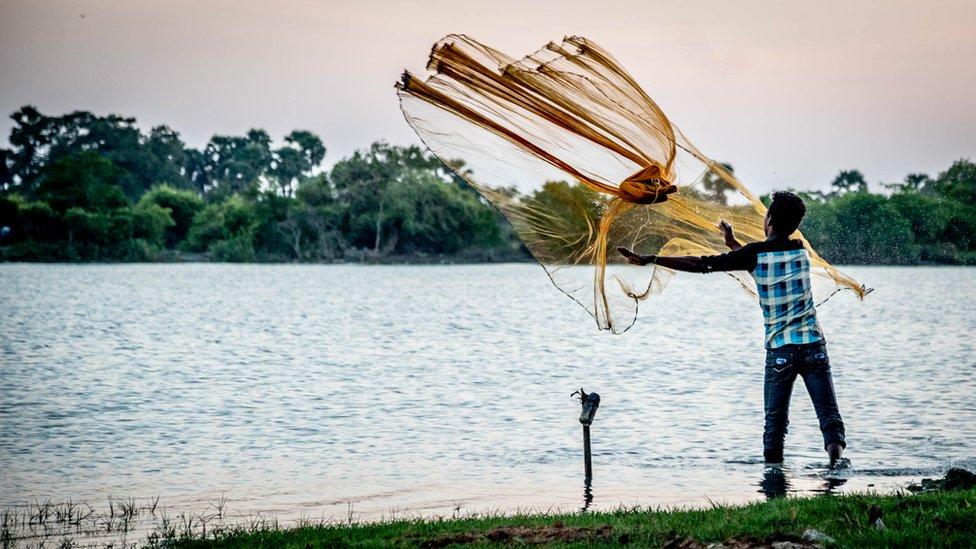
To this day, thousands of people – including friends and former colleagues of Father Francis – regularly take to the streets of northern Sri Lanka to demand answers about the plight of the missing.
Many of the protesters were among 300,000 Tamils who were squeezed into a narrow coastal strip in the final phase of the war. The UN says up to 40,000 of those people died in the final months and countless others were seriously injured. However, the Sri Lankan government disputes that – it has previously put the death toll at less than a quarter of the UN’s figure.
The military insists that those who surrendered were not killed. It does not comment on individual cases.

Moses Arulanandan, now in his 90s, is a close cousin of Father Francis. Haunted by the priest’s disappearance, he’s urged a local court to help and has petitioned the United Nations, both without success.
“All we could do is worry about him and cry,” he said. “We were very close. He was like my biological brother… He was the only son to his parents and I’m the one who used to help his mother as she was living alone while Francis was living at the college.”
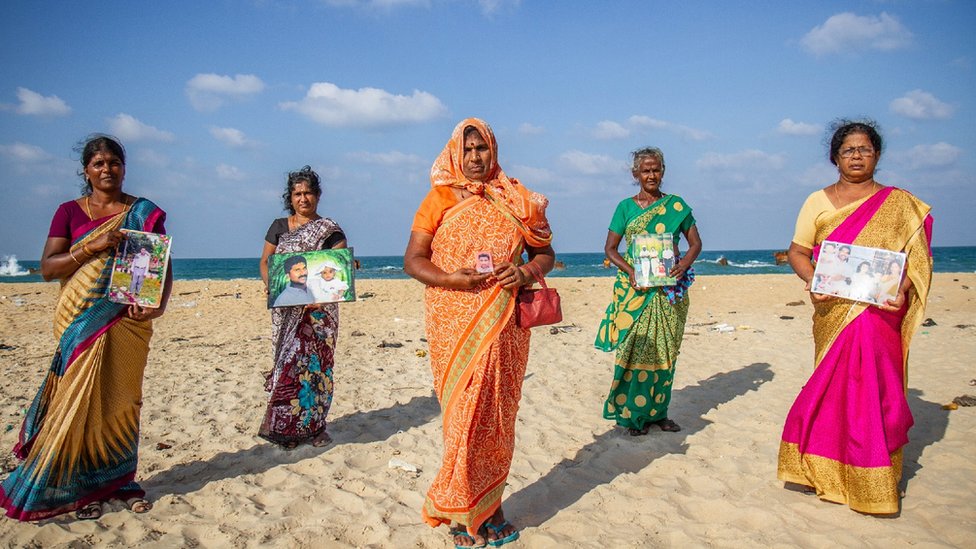
Father Francis first came to St Patrick’s College in Jaffna, northern Sri Lanka, as a schoolboy. After being ordained as a Catholic priest, he returned to the campus as an English teacher and later became school principal. Most of his life was spent between classrooms, the college chapel, and the oval where he cheered on the school cricket team.
- Watch: The final days of Sri Lanka’s civil war
- ‘Why can’t you find our sons?’
- Sri Lanka ‘war crimes’: Main allegations
Former students say that he knew everyone at the school by name. Today, his legacy looms large and a cardboard cut-out of him watches over students in the school library.
“Every day I pray to God and Mary, to show me his whereabouts, to inform me of his status,” cries Mr. Arulanandan, his hands raised in prayer.
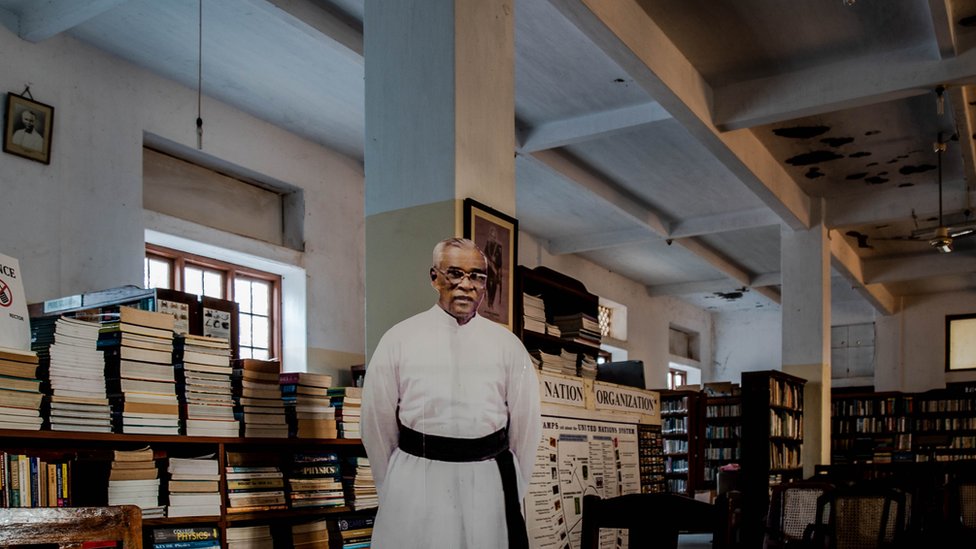
While Father Francis was highly critical of government forces, he remained silent about the atrocities committed by the rebels.
In their mission to create a separate Tamil state, known as Eelam, the Tigers employed brutal tactics, including targeted assassinations, mass killings and the use of both male and female suicide bombers. Between 2002 and 2007 the Tigers are believed to have forcibly recruited at least 6,000 children, and more than 1,300 remain unaccounted for, according to the UN.
In the week leading up to the final surrender, fighters and civilians alike awaited their fate at an army checkpoint in a large field.
Jayakumari Krishnakumar was married to a prominent member of the Tamil Tigers who boarded the bus with Father Francis. She said the priest wrote a list of all those who surrendered.
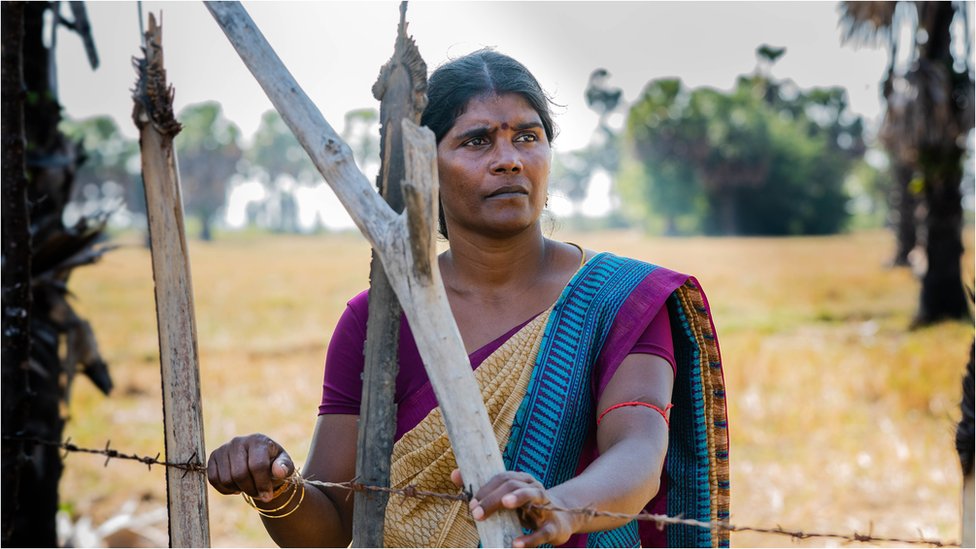
“My husband boarded the bus first, then many others, and finally Father Francis. Father Francis believed the army would respect the white robe,” she recalled. “He seemed scared but believed he’d be OK. And people believed that if they went with him they’d be safe.”
“This particular event is the single largest number of people who have been subject to enforced disappearances at the hands of the Sri Lankan army,” said Yasmin Sooka, a former member of the UN panel of experts on Sri Lanka.
The family members of the missing say they have not been able to find any justice through the courts.
Ms Sooka says the state has failed the missing people. “Once they had surrendered, they were entitled to the protections normally afforded under humanitarian law: to be treated with respect and certainly that you remain with your life intact.”
The military denies that they could have been victims of a war crime.
“People who have surrendered to the army have not been killed – that is for sure,” said spokesman Brigadier Sumith Atapattu.
He added that no prisoners were being held today. “Foreign delegates including the UN have come and checked our camps. There is no underground detention camps in Sri Lanka… People who’ve surrendered or have been captured for terrorist thinking have been accounted for.”
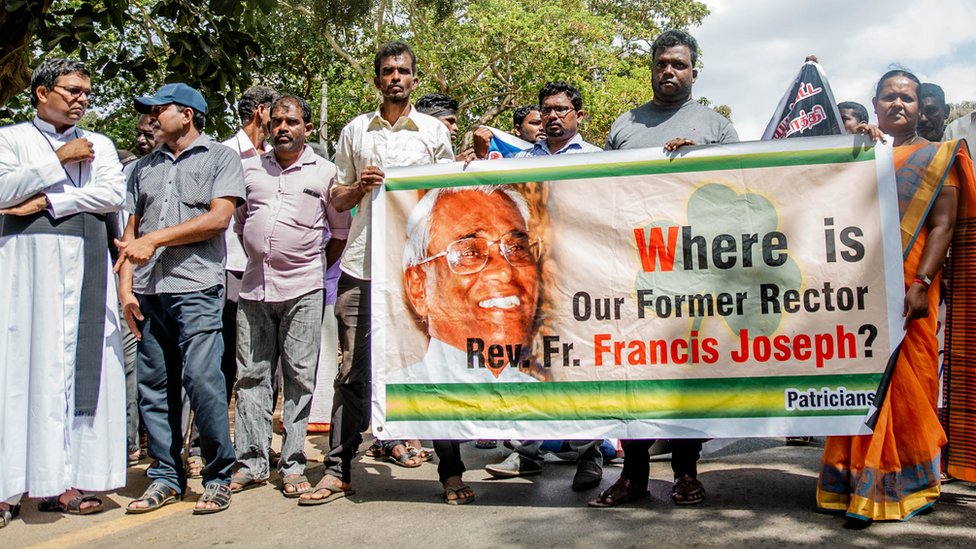
But where is Father Francis?
After years of international pressure the government set up an Office on Missing Persons in 2017. It was given the enormous task of finding thousands of people unaccounted for.
So far not a single person has been found. But the office insists it is trying.
“You can’t just go to the field and say ‘we are looking for people’ – it does not happen that way. The process of tracing, the process of delivering lists, the process of preparing the databases are things that do take time,” said Saliya Pieris, who heads the office.
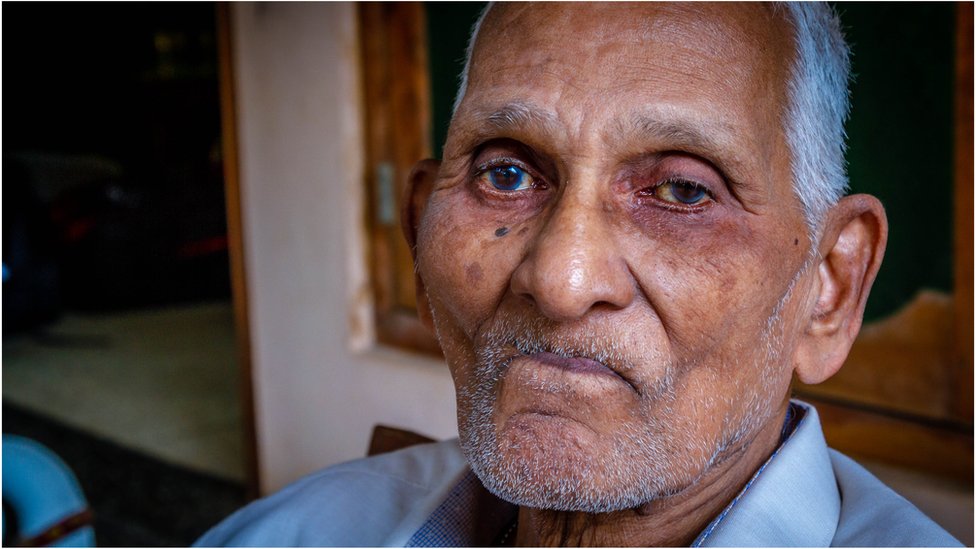
For the families of those that disappeared, there are heartache and hope in equal measure.
The wives of the missing men still wear red bindis on their foreheads, signifying their married status.
Children are still waiting for their parents to come home – and no one has lost faith in finding Father Francis, or at least learning his true fate.
“The truth will come out one day,” said Mr Arulanandan.
Reporting by Swaminathan Natarajan.
Photojournalist Elaine Jung. Produced by Louise Adamou.

Leave a Reply
You must be logged in to post a comment.